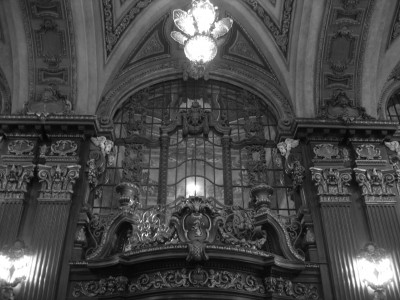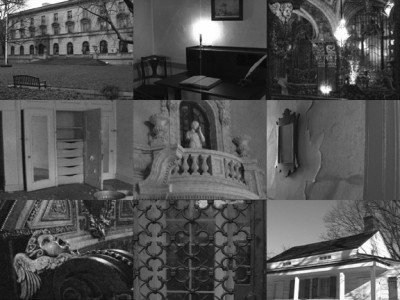Paradise (2005-09)
Paradise (2005-2009)
3-channel video installation, 8:30 min.
Black and White, silent
Paradise was commissioned by the Bronx Museum for the Grand Concourse exhibition. This work resulted from researching the history of three buildings on the Grand Concourse that contain particularly unique stories. The first of them is the Paradise Theater, a grand palace cinema theater which opened in 1929, a few weeks before the stock market crash that led to the Great Depression. The Paradise, which went through many periods and narrowly escaped demolition, remains as one of the sole survivors of the great “atmospheric” palace theater era, and retains a powerful symbolism for Bronx residents as a place of escape and leisure during hard times. The second building addressed is the Andrew Freedman Home, another palatial building of sorts, located just across the street from the Bronx Museum. The Freedman Home was a luxurious retirement place for people who had once been millionaires but had lost their fortunes, providing its residents with fully covered accommodations at no cost. The idea behind this residence was in the will of Andrew Freedman, a quiet and eccentric New York transportation mogul who believed that those who had once experienced wealth would need greater comfort than others who had always lived in poverty. Over the years, the home functioned as originally intended by its founder, although in later decades the endowment of the institution was reduced and eventually transformed it into a regular community center. Like the Paradise Theater, the Andrew Freedman home languished over the years and greatly deteriorated, going from being an impressive structure to a decayed and seemingly abandoned building.
The last building in the project is the Edgar Allan Poe Cottage, a small 19th century house located at Kingsbridge Road and Grand Concourse where Poe spent the last years of his life and wrote some of his best known works such as “Eureka”, “Annabel Lee”, and “The Bells”. Poe moved to this house in 1846, a time when the Bronx was a bucolic area, with the intent of finding a restful haven for his young wife, Virginia, who has ill and he hoped would benefit from the country air. Virginia Clemm was Poe’s cousin and had married him still as a child, at age 14. Virginia’s health deteriorated and she died of Tuberculosis in January of 1847.
The texts that appear in the video relating to this house belong to Poe’s own writing around that time (“Landor’s Cottage” (1849) which is believed to be directly inspired in his Fordham cottage) as well as the only poem known to have been written by Virginia Poe— a Valentine poem written in the style of an acrostic (a poem that spells out the phrase “Edgar Allan Poe” if one reads the first letter of every line):
E ver with thee I wish to roam –
D earest my life is thine.
G ive me a cottage for my home
A nd a rich old cypress vine,
R emoved from the world with its sin and care
A nd the tattling of many tongues.
L ove alone shall guide us when we are there –
L ove shall heal my weakened lungs;
A nd Oh, the tranquil hours we’ll spend,
N ever wishing that others may see!
P erfect ease we’ll enjoy, without thinking to lend
O urselves to the world and its glee –
E ver peaceful and blissful we’ll be.
paradise-ii_freedman
Tags: Architecture, Art of Memory, Biography, Counterpoint, Film, Geography, History, Installation, Memory, New York City, Paradise, Sociology, Urbanism, Utopia

